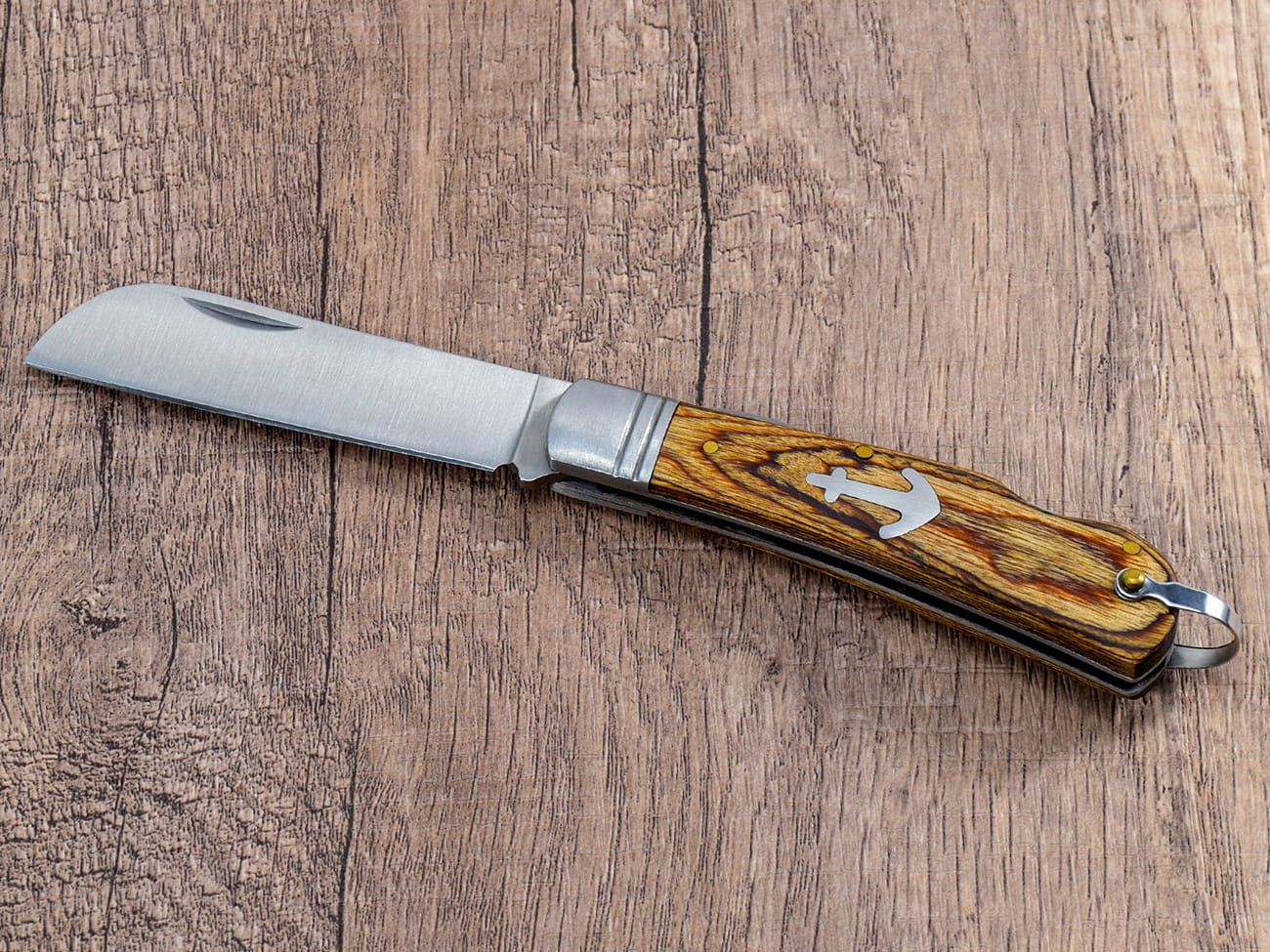Pisau saku telah menjadi alat penting bagi manusia selama ribuan tahun, berevolusi dari alat pemotong sederhana menjadi barang serbaguna yang dapat dibawa sehari-hari (EDC). Artikel ini akan membahas sejarah pisau saku yang menarik, menelusuri asal-usulnya dari zaman kuno hingga era modern. Kita akan membahas bagaimana pisau lipat yang ringkas ini beradaptasi dengan kebutuhan dan teknologi yang terus berubah, menjadi teman yang sangat diperlukan bagi jutaan orang di seluruh dunia.
Mengapa Artikel Ini Layak Dibaca
Memahami sejarah pisau saku memberikan wawasan berharga tentang kecerdikan manusia dan evolusi peralatan sehari-hari. Apakah Anda seorang penggemar pisau, penggemar sejarah, atau sekadar ingin tahu tentang barang-barang yang kita gunakan sehari-hari, penjelajahan sejarah pisau saku ini menawarkan perspektif unik tentang bagaimana alat sederhana telah membentuk kehidupan kita dan terus relevan di dunia modern.
Asal Usul Pisau Lipat: Akar Kuno
Konsep pisau lipat sudah ada jauh sebelum banyak orang menyadari. Meskipun pisau saku modern seperti yang kita kenal sekarang merupakan penemuan yang relatif baru, ide tentang alat pemotong yang portabel dan dapat dilipat sudah ada sejak lama.
Kapan Pisau Lipat Pertama Diciptakan?
Bukti arkeologi menunjukkan bahwa pisau lipat pertama kali muncul pada Zaman Besi, sekitar 500-600 SM. Contoh-contoh awal ini ditemukan di berbagai bagian Eropa dan wilayah Mediterania, yang menunjukkan bahwa konsep pisau lipat dikembangkan secara independen dalam berbagai budaya.
Seperti Apa Pisau Lipat Awal?
Pisau lipat awal sangat berbeda dengan pisau saku yang kita gunakan saat ini. Pisau lipat biasanya memiliki mekanisme putar sederhana dan tidak memiliki sistem pengunci canggih yang ditemukan pada desain modern. Bilahnya sering kali terbuat dari besi atau perunggu, dan gagangnya dapat dibuat dari tulang, kayu, atau bahan lain yang tersedia.
Evolusi Pisau Saku Sepanjang Sejarah
Seiring dengan kemajuan peradaban, desain dan fungsi pisau lipat pun ikut berkembang. Mari kita telusuri bagaimana pisau saku berevolusi melalui berbagai periode sejarah.
Bagaimana Pisau Saku Berubah pada Abad Pertengahan?
Selama Abad Pertengahan, pisau lipat menjadi lebih canggih dan mulai menyerupai pisau saku yang kita kenal saat ini. Para perajin mengembangkan teknik pengerjaan logam yang lebih baik, sehingga menghasilkan pisau yang lebih tajam dan lebih tahan lama. pisau sambungan selip mekanisme, yang masih digunakan di banyak pisau saku modern, diperkenalkan selama periode ini.
Apa Peran Pisau Saku di Era Eksplorasi?
Saat penjelajah Eropa mulai menjelajahi wilayah baru, pisau lipat menjadi alat penting untuk bertahan hidup dan tugas sehari-hari. Para pelaut, khususnya, sangat bergantung pada pisau lipat mereka untuk berbagai tugas di atas kapal. Periode ini menyaksikan perkembangan bentuk bilah pisau yang lebih khusus dan diperkenalkannya alat tambahan dalam beberapa desain.
Bagaimana Revolusi Industri Berdampak pada Produksi Pisau Saku?
Revolusi Industri membawa perubahan signifikan dalam pembuatan pisau saku. Teknik produksi massal memungkinkan standarisasi yang lebih baik dan biaya yang lebih rendah, sehingga pisau saku lebih mudah diakses oleh masyarakat umum. Era ini juga menyaksikan munculnya pusat pembuatan pisau terkenal seperti Sheffield di Inggris, yang menjadi terkenal karena memproduksi pisau berkualitas tinggi. pisau lipat.

Desain pisau saku klasik dengan gagang kayu dan bilah yang diampelas, mengingatkan pada pengerjaan tradisional
Kelahiran Desain Pisau Saku Modern
Akhir abad ke-19 dan awal abad ke-20 menyaksikan kemajuan pesat dalam desain pisau saku, yang menghasilkan banyak fitur yang kita kaitkan dengan pisau lipat modern.
Kapan Pisau Swiss Army Diciptakan?
Salah satu desain pisau saku paling ikonik, Pisau Swiss Army, pertama kali diproduksi pada tahun 1891. Karl Elsener menciptakan "Pisau Prajurit" asli untuk Swiss Army, yang dilengkapi berbagai alat dalam desain yang ringkas dan dapat dilipat. Alat serbaguna ini kemudian menjadi simbol fungsionalitas dan ketepatan Swiss di seluruh dunia.
Apa Dampak dari Pisau Barlow?
Pisau Barlow, yang diperkenalkan pada akhir abad ke-17, menjadi pelopor dalam desain pisau saku. Konstruksinya yang kokoh dan harganya yang terjangkau membuatnya sangat populer, terutama di Amerika. Pengaruh Barlow masih dapat dilihat pada banyak desain pisau saku modern.
Bagaimana Mekanisme Penguncian Merevolusi Pisau Saku?
Perkembangan mekanisme penguncian yang andal pada abad ke-20 secara signifikan meningkatkan keamanan dan fungsionalitas pisau saku. Inovasi seperti kunci liner, kunci bingkai, dan kunci kembali membuat pisau lipat jauh lebih aman digunakan, memperluas potensi penerapannya.
Pisau Saku di Abad ke-20: Dari Perkakas hingga Barang Koleksi
Pada abad ke-20, pisau saku beralih dari alat yang semata-mata berguna menjadi objek koleksi dan apresiasi.
Bagaimana Perang Dunia Memengaruhi Desain Pisau Saku?
Kedua Perang Dunia tersebut memiliki dampak signifikan pada desain dan produksi pisau saku. Pisau yang digunakan militer sering kali dilengkapi dengan peralatan tambahan dan konstruksi yang lebih kuat. Banyak dari fitur ini kemudian digunakan pada pisau saku sipil.
Apa yang Menyebabkan Maraknya Koleksi Pisau?
Seiring dengan semakin beragamnya desain dan bahan pisau saku, budaya mengoleksi pisau pun muncul. Edisi terbatas, model peringatan, dan pisau antik menjadi sangat dicari oleh para penggemar. Tren ini berlanjut hingga kini, dengan beberapa pisau saku langka yang laku keras di kalangan kolektor.
Bagaimana Ilmu Material Memajukan Teknologi Pisau Saku?
Kemajuan dalam ilmu metalurgi dan material menyebabkan peningkatan signifikan pada baja bilah dan material pegangan. Baja berkinerja tinggi seperti D2 dan 8Cr13MoV menawarkan retensi tepi yang lebih baik dan ketahanan terhadap korosi. Material pegangan baru seperti G10 dan titanium memberikan daya tahan dan mengurangi berat.
Inovasi Modern dalam Desain Pisau Saku
Akhir abad ke-20 dan awal abad ke-21 telah menyaksikan inovasi berkelanjutan dalam desain pisau saku, dengan teknologi baru dan kebutuhan pengguna yang mendorong pengembangan.
Apa Tren Terbaru dalam Bahan Pisau Saku?
Pisau saku modern sering kali memiliki bahan canggih seperti pegangan serat karbon untuk kekuatan yang ringan, bilah keramik untuk ketajaman yang ekstrem, dan paduan baja eksotis untuk kinerja yang unggul. Produsen terus bereksperimen dengan material baru untuk meningkatkan daya tahan, fungsionalitas, dan estetika.
Bagaimana Budaya EDC Memengaruhi Desain Pisau Saku?
Meningkatnya budaya EDC (Everyday Carry) telah memberikan dampak signifikan pada desain pisau saku. Banyak pisau modern yang dioptimalkan untuk dibawa di perkotaan, dengan profil ramping, klip saku yang dapat dibawa dalam, dan fitur yang membuatnya lebih tersembunyi dan nyaman untuk penggunaan sehari-hari.
Peran Apa yang Dimainkan Pembuat Pisau Kustom dalam Evolusi Pisau Saku Modern?
Pembuat pisau kustom terus mendorong batasan desain pisau saku, sering kali memperkenalkan fitur inovatif dan elemen artistik yang akhirnya masuk ke dalam model produksi. Pasar pisau kustom juga telah memengaruhi munculnya pisau "teknologi menengah", yang menggabungkan elemen produksi dan kustom.
Masa Depan Pisau Saku: Apa Selanjutnya?
Saat kita melihat ke masa depan, pisau saku terus berkembang untuk memenuhi kebutuhan dan teknologi yang berubah.
Bagaimana Integrasi Teknologi Dapat Mengubah Pisau Saku?
Beberapa pembuat pisau bereksperimen dengan mengintegrasikan teknologi ke dalam pisau saku, seperti lampu LED internal, drive USB, atau bahkan fitur pintar yang dapat melacak lokasi pisau atau memantau kondisinya.
Pertimbangan Lingkungan Apa yang Membentuk Desain Pisau Saku?
Dengan meningkatnya kepedulian terhadap lingkungan, beberapa produsen mulai mengeksplorasi bahan dan metode produksi yang lebih berkelanjutan untuk pisau saku. Ini termasuk menggunakan bahan daur ulang, mengembangkan opsi pegangan yang dapat terurai secara hayati, dan meningkatkan keawetan pisau untuk mengurangi limbah.
Bagaimana Perubahan Hukum dan Peraturan Dapat Mempengaruhi Desain Pisau Saku?
Karena undang-undang tentang membawa pisau terus berkembang, desainer mungkin perlu menyesuaikan kreasi mereka agar sesuai dengan berbagai peraturan. Hal ini dapat mengarah pada lebih banyak fokus pada perkakas multifungsi atau pisau dengan bilah yang mudah diganti untuk memenuhi berbagai persyaratan hukum.
Kesimpulan: Warisan Pisau Saku yang Abadi
Dari asal usulnya yang kuno hingga perlengkapan EDC modern, pisau saku telah terbukti menjadi salah satu perkakas manusia yang paling tahan lama dan serbaguna. Evolusinya mencerminkan perubahan kebutuhan, kemajuan teknologi, dan pergeseran budaya. Seiring dengan perkembangan zaman, pisau saku niscaya akan terus beradaptasi, dan tetap menjadi bagian tak terpisahkan dari kehidupan kita sehari-hari.
Poin-poin Utama:
- Pisau lipat punya asal usul yang kuno, yang berasal dari Zaman Besi.
- Revolusi Industri secara dramatis meningkatkan ketersediaan dan variasi pisau saku.
- Desain ikonik seperti Pisau Swiss Army dan pisau Barlow telah membentuk lanskap pisau saku modern.
- Kemajuan dalam material dan manufaktur telah menghasilkan pisau saku yang berkinerja tinggi dan tahan lama.
- Budaya EDC dan pembuat pisau khusus terus memacu inovasi dalam desain pisau saku.
- Pisau saku masa depan mungkin menggabungkan teknologi baru dan berfokus pada keberlanjutan.
Baik Anda seorang kolektor, penggemar kegiatan luar ruangan, atau seseorang yang menghargai desain fungsional, sejarah pisau saku yang kaya menawarkan sesuatu untuk semua orang. Seiring dengan terus berkembangnya alat serbaguna ini, alat ini tetap menjadi bukti kecerdikan manusia dan kemampuan kita untuk menciptakan solusi praktis untuk tantangan sehari-hari.




